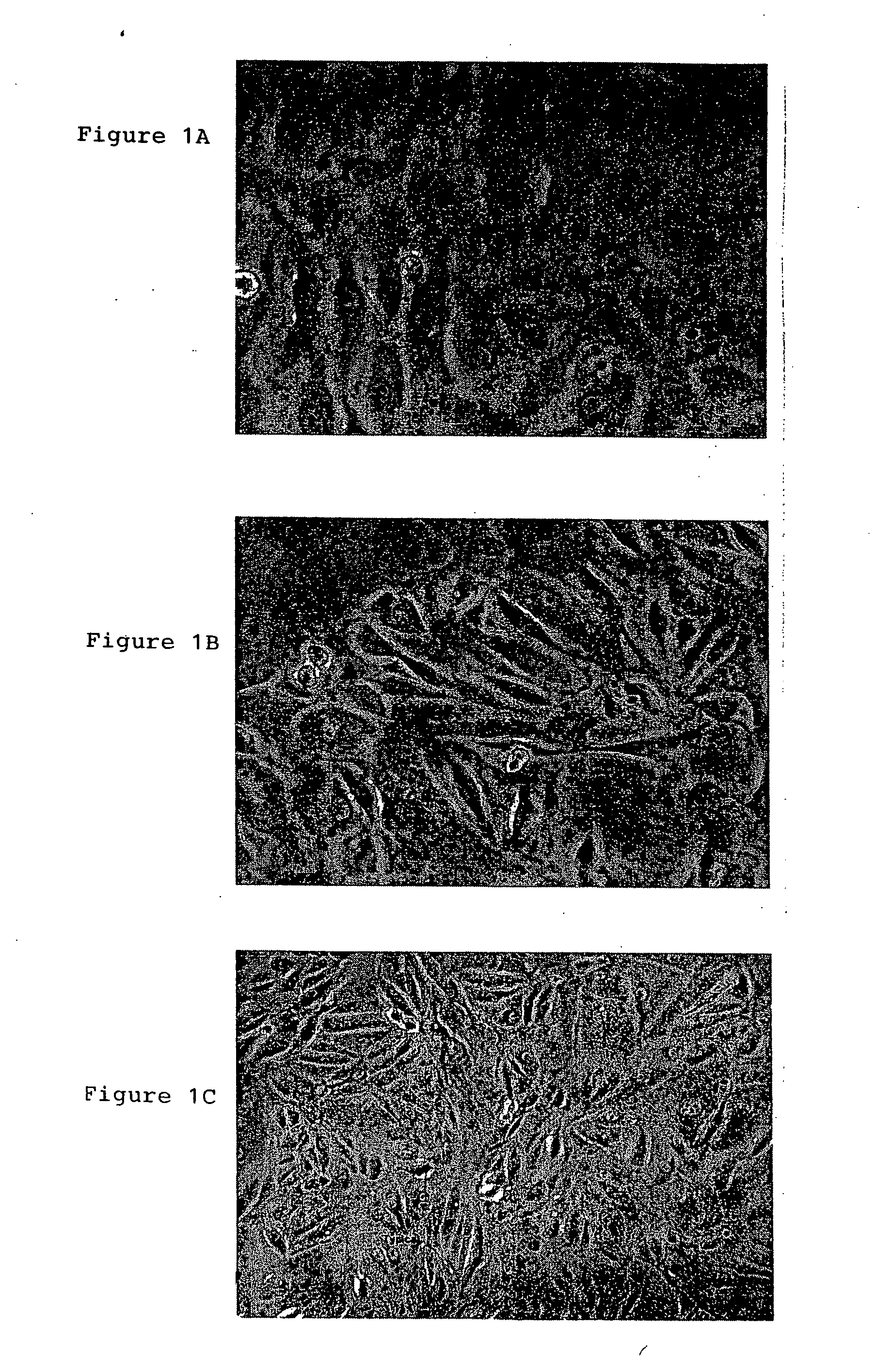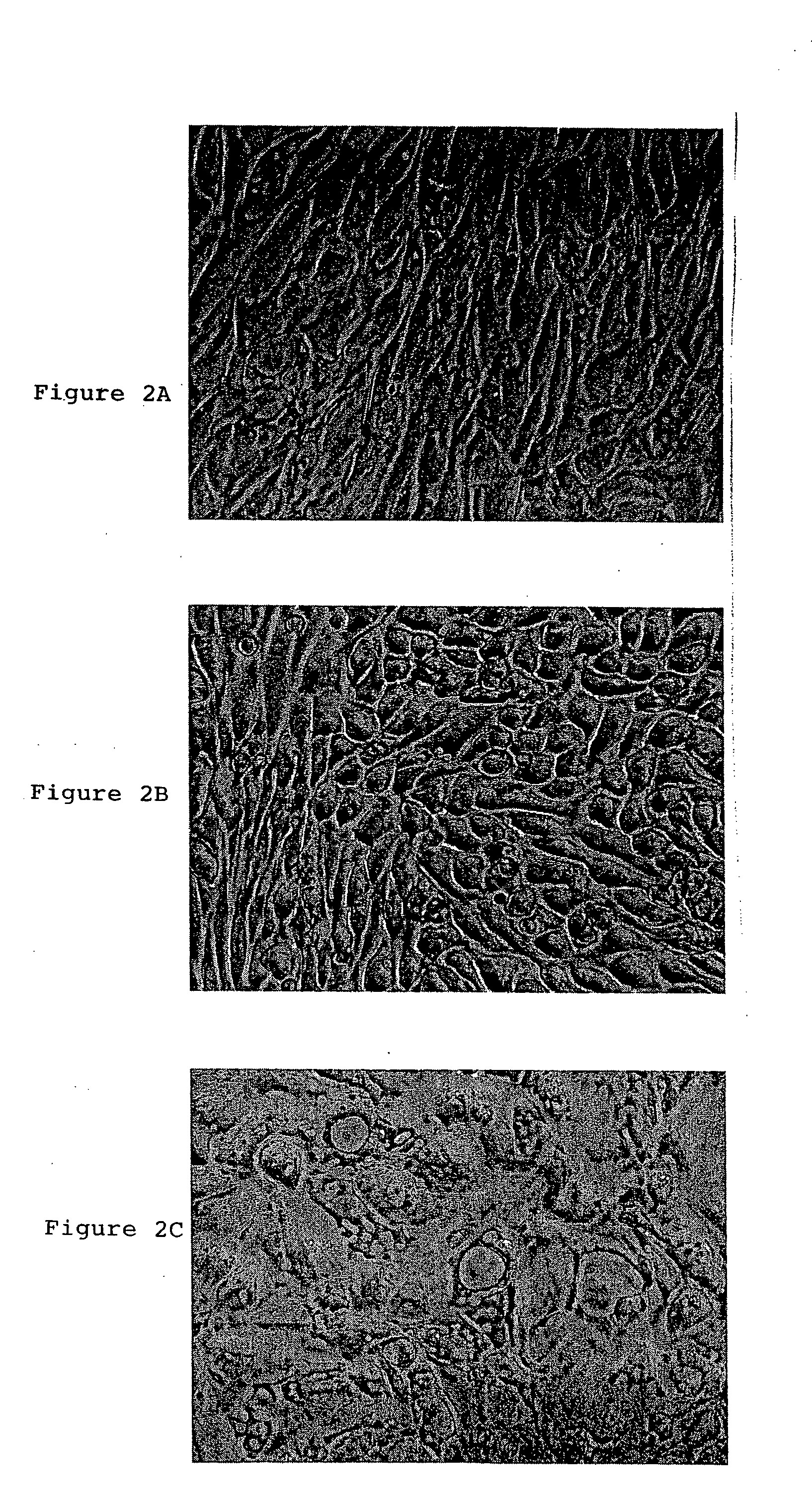Multipotent amniotic fetal stem cells
a technology of amniotic fluid and stem cells, which is applied in the field of stem cell research, can solve problems such as tumorigenic attributes
- Summary
- Abstract
- Description
- Claims
- Application Information
AI Technical Summary
Benefits of technology
Problems solved by technology
Method used
Image
Examples
example 1
Isolation and Expansion of Undifferentiated Cells Derived from Amniotic Fluid
[0056] Approximately 2 to 5 ml of fresh amniotic fluid was harvested from women undergoing routine amniocentesis at 16 to 21 weeks of pregnancy (2nd trimester). Second trimester amniotic fluid contained approximately 1-2×104 live cells per ml. The cells were pelleted in a clinical centrifuge and resuspended in 15 ml “MAFSC” medium. MAFSC medium was composed of low glucose Dulbecco Modified Eagle's Medium (GIBCO, Carlsbad, Calif.) and MCDB 201 medium (SIGMA, Saint Louis, Mo.) at a one to one ratio and contained 2% Defined Fetal Calf Serum (HYCLONE, Logan, Utah), 1× insulin-transferrin-selenium, linoleic-acid-bovine-serum-albumin (ITS+1, SIGMA), 1 nanomolar dexamethasone (Sigma), 100 μm ascorbic acid 2-phosphate (Sigma), 4 μm / ml gentamycin, 10 ng / ml of rhEGF (R&D Systems, Minneapolis, Minn.), 10 ng / ml rrPDGF-BB (R&D) and 10 ng / ml rhFGF-basic (R&D). The wells of 6-well culture dishes were prepared for cell pl...
example 2
Morphological Characterization of Cell Types
[0059] Cultured amniotic fluid-derived cells were tested for cell surface and differentiation markers and were karyotyped. These cells were found to be immortal or near-immortal and were named Multipotent Amniotic Fetal Stem Cells (MAFSC).
[0060] All of >80 amniotic fluid sample harvests of 5 ml gave rise to at least one adherent MAFSC colony and continuous culture. The majority of sample harvests gave rise to 3-4 individual clones. Among the individual clones, different colonies / cultures had diverse colony morphologies, as shown in FIG. 1. Some cultures had a flat, epihelial morphology (FIG. 1A). Others had a fibroblastic morphology (FIGS. 1B, 1C). Both the epithelioid and the fibroblastic classes of cultures senesced after ˜60 population doublings (PD), yielding a maximum of 1018 cells, unless the cells were immortalized by the expression of the human TERT (telomerase) gene that maintained the length of the cells' telomeres. Indeed, mor...
example 3
FACS Analysis of MAFSC Cells
[0062] Cells were prepared for FACS analysis by trypsinizing to remove them from the tissue culture flask, washing in buffer, HBSS, 2% BSA, 0.1% sodium azide, then resuspended in 100 μL of the same buffer. For intracellular antigens (i.e. Oct-4), the cells were fixed and permeablized using Beckman-Coulter IntraPrep reagents, as suggested by the manufacturer. Primary antibodies specific for the indicated cell-surface or intracellular marker were added at a 1:10 dilution and incubated for 30 minutes at room temperature, then washed. For samples using primary antibodies that were not fluorescently-conjugated, the cells were then resuspended in 250 μL of buffer and the appropriate fluorescent-labeled secondary antibody was added at a 1:250 dilution and incubated for 30 minutes at room temperature. Labeled cells were washed and resuspended in buffer or 1% paraformaldehyde for analysis by a FACSCalibur flow cytometer. The data obtained from this analysis were ...
PUM
| Property | Measurement | Unit |
|---|---|---|
| doubling time | aaaaa | aaaaa |
| composition | aaaaa | aaaaa |
| surface | aaaaa | aaaaa |
Abstract
Description
Claims
Application Information
 Login to View More
Login to View More - R&D
- Intellectual Property
- Life Sciences
- Materials
- Tech Scout
- Unparalleled Data Quality
- Higher Quality Content
- 60% Fewer Hallucinations
Browse by: Latest US Patents, China's latest patents, Technical Efficacy Thesaurus, Application Domain, Technology Topic, Popular Technical Reports.
© 2025 PatSnap. All rights reserved.Legal|Privacy policy|Modern Slavery Act Transparency Statement|Sitemap|About US| Contact US: help@patsnap.com



